Top News
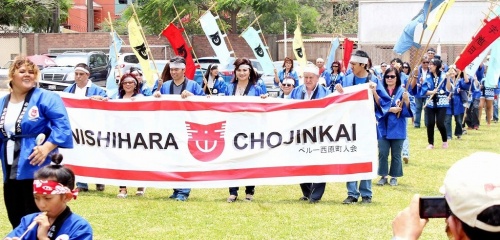
February 9, 2016 Ryukyu Shimpo
By Yoshiki Nagahama
The Okinawan Association of Peru hosted an Okinawan festival and sports competition between municipalities at the association’s sports fields in Lima, Peru, on February 7. The festival grounds were decked out in Okinawan décor, food stalls sold pigs’ feet and sata andagi, and there were eisa and sanshin performances on the festival stage. Participants even took the stage to demonstrate Ryukyu dance, sing Okinawan folk songs, or perform songs written by Okinawan musical groups.
About 500 marchers from 17 municipalities within Okinawa making up the Okinawan Association of Peru put on a parade at the festival. Marchers representing each municipality wore happi coats, and hoisted flags and placards proclaiming their native region. Coinciding with the parade, participants in the sports competition played sports such as soccer and gateball.
Vice-governor of Okinawa and leader of the Okinawa Prefectural South America Caravan Mitsuo Ageda visited Peru and came to the festival. He spoke at an information session about the 6th Worldwide Uchinanchu Festival, and requested that those gathered attend the worldwide festival. At the opening ceremony for the sports competition he repeated this request.
(English translation by T&CT and Erin Jones)
Go to Japanese
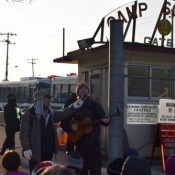
February 9, 2016 Ryukyu Shimpo
On the early morning of February 9, a total of around 100 protesters opposing the relocation of U.S. Marine Corps Air Station Futenma to Henoko, Nago gathered in front of Camp Schwab. Around 50 protesters each gathered in front of two of Camp Schwab’s gates. The sit-in protests previously held in front of yet another gate were not held, and around ten vehicles appearing to be related to the base construction entered that gate. No visible construction work was conducted offshore in the waters adjacent to Camp Schwab.
Starting from before 7 a.m., around 100 prefectural police officers and riot police from the Tokyo Metropolitan Police Department waited at the gate where sit-in protests are usually held, but since protesters were not there, they did not need to remove anyone from the scene. Protesters instead marched and demonstrated in front of the other two gates, calling out, “Stop illegal land reclamation now!” and other calls of protest.
Joining the protests was Jason Rawn, 42, an American from Maine who came to Okinawa and participates in the peace movement. Loan performed on the guitar and sang Johnny Cash’s “Don’t Take Your Guns To Town,” a song calling for peace and nonviolence. He directed the song to those inside the base.
(English translation by T&CT and Sandi Aritza)
Go to Japanese
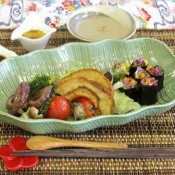
February 3, 2016 Ryukyu Shimpo
On January 29, Okinawa Prefectural Government and Okinawa Convention & Visitors Bureau (OCVB) held the final selection meeting for a Muslim recipe contest, created to attract visitors from Muslim countries, at Tiruru (Okinawa Gender Equality Center), Naha.
The contest has two sections, the Vegetarian section, mainly using Okinawan vegetables, and the Non-Pork, Non-Alcohol section.
Okinawa Genki Norimaki (seaweed roll) and Colorful Salad presented by Yosemiya, a frozen meal supplier, won the top prize in the Vegetarian section, and a full-course meal highlighting fresh Okinawan vegetables, presented by Kafuu Resort Fuchaku Condo Hotel, received the top prize in the Non-pork, Non-alcohol section.
(English translation by T&CT, Hitomi Shinzato)
Go to Japanese
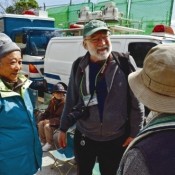
February 5, 2016 Ryukyu Shimpo
Documentary filmmaker John Junkerman, who made the full-length documentary movie The Afterburn (“Okinawa: Urizun no Ame”), visited Camp Schwab gate to film the people who are protesting against the new U.S. military base construction in Henoko, Nago City, on February 4. As the film will be screened in the United States, the filmmakers will add new interviews of participants in the protest movement at the gate to reflect the current situation.
Junkerman said he would like to show audiences in the United States the people who dedicate themselves to prevent the base construction.
The Veterans for Peace, a peace group of retired US soldiers, will take the initiative in holding screening events around the United States.
The movie depicts the modern history of Okinawa, in which the war created an adverse situation on Okinawa. It also traced the issue of U.S. military bases in Okinawa, including the Henoko relocation. The documentary ranked first in the Kinema Junpo Best Ten ranking in the Cultural Movie genre last year.
The documentary is expected to include interviews with youths such as Ai Tamaki from SEALDs Ryukyu and researchers, in addition to the sit-in participants.
(English translation by T&CT and Sayaka Sakuma)
Go to Japanese
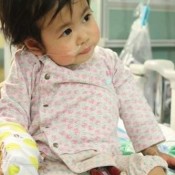
February 10, 2016 Ryukyu Shimpo
One-year-old Noa Onaga who was diagnosed with dilatation of the myocarditis, which decreases heart activity, has been staying in the United States for a heart transplant. From February 5 to 6, she had the successful operation at Columbia University. She is currently on a respirator in an intensive care unit. Although she is still unconscious, her condition is good and stable after the operation.
(English translation by T&CT)
Go to Japanese
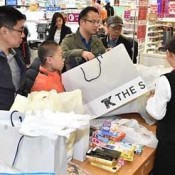
February 9, 2016 Ryukyu Shimpo
By Wu Li Jun
The Lunar New Year began on February 6, and many Chinese and Taiwanese tourists are visiting Okinawa as a result. Tourists have been flooding into large-scale shopping malls, adding to the liveliness Products on their checklist include home electronic appliances and cosmetics. As a result, a large-scale shopping mall in Chatan has made a 20 percent year-on-year increase in sales. In addition, the takings from tax-exempt products in department stores within Naha City has increased from last year. According to officials, three large cruise ships will be making trips to Naha Port on February 13. This will lead to more aggressive spending by overseas tourists.
At Chatan AEON Shopping Mall, measures have been taken in order to accommodate the influx of Chinese tourists. For example, they have set up a special section to sell about 300 types of products, which are especially popular among tourists during the Lunar New Year. According to Ryukyu AEON Shopping Mall located in Haebaru Town, the average consumption amount (unit price) per overseas visitor ranges between 15,000 and 20,000 yen. However, when it comes to medicine and cosmetics, the price spent per person rises to between 40,000 and 60,000 yen.
At San-A Naha Main Place, the consumption amount (unit price) per overseas tourist ranges between 20,000 and 30,000 yen. Last year, expensive home electronic appliances, such as rice cookers, sold well. This year, beauty products such as dryers, which are around 20,000 yen on average in unit price, are making major sales. Store manager Kazuto Ohshiro said, “Seven large cruise ships will be making trips to Naha this year during the Lunar New Year period.
That’s a lot more compared to last year, when there was only one trip. We expect to see more customers as a result.”
Ryubo Department store has seen a slightly increasing in the amount spent on tax-exempt products during the first three days of the Lunar New Year than last year. It expects its sales to grow from the middle to the end of the holiday period. One representative commented, “Ever since we extended the range of consumption tax-free products from October 2014, we have seen a steady increase in the amount spent on tax exempt products. Now that we’ve entered February, we have managed to double the takings from such products per week, compared to what we had last year.”
Kai-Xiang Zhang, a 21-year-old Taiwanese tourist visiting Okinawa for the first time said, “Thanks to the weak yen, I was able to buy many medicines and cosmetics. I don’t have any budget limit set aside for shopping on this trip, so I’d like to go ahead and buy more things.”
(English Translation by T&CT, Kaya Doi)
Go to Japanese
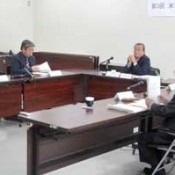
February 4, 2016 Ryuykyu Shimpo
Okinawa Prefectural Government (OPG) has included proposals to ask for the Japanese government’s intervention into a draft of the “Environmental Survey Guidelines,” which OPG aims to decide upon in March 2017, to clarify the government’s handling of environmental pollution issues arising from the U.S. military bases. On February 3 at the OPG Environmental Policy Division Military Related Environment Special Task Force showed the proposals at the third meeting of the U.S. Military Facilities Environmental Provision Exploratory Committee.
The proposals added in the guidelines include (1) to set up a system for the Ministry of Environment to intervene in military base pollution; (2) to regulate chemical substances, which are not listed under laws, in a system. The committee is asking to apply an Environmental Impact Assessment (EIA) in the areas planned for return to Japan.
In April, the committee will establish four task forces, including a “Community Involvement Information Disclosure Special Task Force.” The committee will solidify the content of the guidelines by next March.
In the past, when environmental pollution was found in a former military area, OPG and municipalities discussed countermeasures. By consolidating the countermeasures in the guidelines, the OPG aims to establish a system to handle such issues effectively.
The guidelines also emphasize releasing information to and taking in opinions from residents. The committee considers the establishment of a Japanese version of the Restoration Advisory Board (RAB), which is a U.S. Army forum, for the full public involvement in restoration decisions. The committee will also set 1) policies on cleanup standards and methods, and 2) an impact assessment on the natural environment and the historical and cultural environment such as wells and sanctuaries.
In regard to concerns of ground contamination on the U.S. military bases, the committee suggests visualizing the changing condition of the landscape based on satellite images. For water pollution, the committee will make maps of underground water. While the committee had planned to set up a special task force for aircraft noise, it deferred the establishment of the task force next year because the committee has insufficient knowledge about the new noise index “Lden.”
(English translation by T&CT and Megumi Chibana)
Go to Japanese
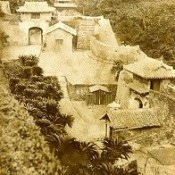
February 6, 2016 Ryukyu Shimpo
Rare photographs of Shuri Castle and other scenes in Okinawa, which, experts speculate, were taken soon after Haihan-chiken, the feudal domain system, was abolished and the prefectural system was introduced in Okinawa in 1879, were found among the possessions of the the Uesugi family in Yonezawa City, Yamagata Prefecture. Mochinori Uesugi from Yamagata, formerly known as Yonezawa Han in the Tohoku area, was the second Okinawa prefectural governor, from 1881 to 1883. Shuri Castle was destroyed during the Battle of Okinawa.
The photograph of Shuri Castle was taken from an angle overlooking the main gate Kankaimon and the Kyukeimon from the top of the castle wall at the back of the Hokuden (North Hall).
Okinawa history experts claim this is a valuable photograph.
Eight photographs featuring Okinawa are on view in the special exhibition titled “The Uesugi family’s old photographs – the Earl Uesugi’s life in Yonezawa,” which started on February 6 and will end on March 21.
Included are photographs of Shurei no mon, or Shurei gate; port scenes at Watanji and Tondo; Sogenji Bridge; a performer of Kumiodori, traditional Okinawan music and dance drama; and a woman in the entertainment area in Tsuji. The pictures are Japanese business card size (9 cm x 5.5 cm).
Professor emeritus at the University of Ryukyus Kurayoshi Takara, who was involved in the restoration work of Shuri Castle, said, “This is the first photograph that provides a whole image of the barbican of Kyukeimon and its proportions.” He added, “We can feel the atmosphere of the Shuri Castle in those bygone days before the Kumamoto garrison, a garrison of soldiers of the Imperial Japanese Army stationed in Okinawa, reformed it. It is a valuable photograph.”
For further details, call the Yonezawa City Uesugi Museum on 0238-26-8001.
(English translation by T&CT)
Go to Japanese
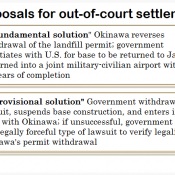
February 3, 2016, Ryukyu Shimpo
After Okinawa governor Takeshi Onaga withdrew the permit to reclaim land in Henoko, Nago for the construction of a U.S. military base, he was sued by the Japanese government, which sought the authority to approve the land reclamation by proxy, arguing that the governor’s withdrawal of the permit was illegal. Partway through the trial at the Naha branch of the Fukuoka High Court, presiding judge Toshiro Tamiya urged the two parties to come to an out-of-court settlement, presenting two potential compromise proposals. The content of the two proposals was made public on February 2. One proposal, touted as a “fundamental solution,” suggests that Okinawa reverse its withdrawal of the permit, in exchange for with the Japanese government should negotiate with the U.S. to have the new base either returned to Japanese administration or turned into a joint military-civilian airport sometime within thirty years of being built. The other proposal, a “provisional solution,” suggests that the Japanese government withdraw the lawsuit, suspend construction of the base, and enter into talks with the Okinawa prefectural government. If the talks prove unfruitful, the proposal suggests that the government then file a different, less legally forceful type of lawsuit to verify the legality of the permit withdrawal. Judge Tamiya also announced that if the parties refuse to accept either of the compromise proposals, a final verdict will be handed down on April 13.
This is the first time a court has proposed, as an option for settling out of court, that a Japanese prefecture accept the construction of a U.S. military base.
Because the “fundamental solution” proposal, which stipulates that the Japanese government negotiate with the U.S. to have the base returned within 30 years, goes against Governor Onaga’s campaign pledge to prevent the Henoko base from being built, it is unlikely to be accepted by Okinawa. It is also unlikely that the Japanese government would accept a proposal placing a time limit on the use of a U.S. military base.
Judge Tamiya recommended that the two parties reach an out-of-court settlement at the end of the trial’s third hearing on January 29. The two compromise proposals were announced thereafter during a session of ongoing private talks between the two parties. The court urged both parties not to publicize the content of the two proposals.
Speaking to the press on January 29 after the hearing, Governor Onaga said that the out-of-court settlement proposals had come as a complete surprise, and that he would proceed to review the proposals while consulting with relevant players. On the same day, Chief Cabinet Secretary Yoshihide Suga told the press that the government will proceed to investigate whether it can accept either of the proposals.
The team of lawyers representing Governor Onaga argued that in order to review the two proposals, it must provide relevant information to the Okinawa prefectural assembly. On February 1 the team put in a request to the Naha branch of the Fukuoka High Court asking that it be permitted to disclose the information to prefectural assembly members. According to the lawyers, the court said it would review the request after also receiving the opinion of the government on the matter.
If the trial proceeds, Governor Onaga will be questioned on February 15. On February 29, Nago mayor Susumu Inamine will be questioned as a witness, and the trial will conclude on the same day.
(English translation by T&CT and Sandi Aritza)
Go to Japanese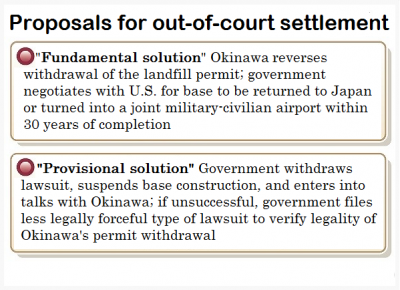
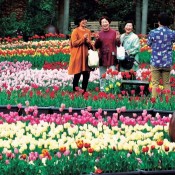
January 28, 2016 Ryukyu Shimpo
On January 27, Okinawa’s historic cold weather eased away and a tulip fair started at the Tropical Dream Center in Okinawa Expo Park, Motobu. Visitors enjoyed about 80,000 tulips in 48 varieties.
Naoko Yashiki, who visited the park from Saitama with her family, said, “Okinawa is warm.” Her five-year-old daughter Shiori said with a smiling face, “Pink tulips are cute.”
Haruho Yagi, a staff member at the center, said, “We also want many local people to see the tulips.”
(English translation by T&CT, Hitomi Shinzato)
Go to Japanese
February 2, 2016 Ryukyu Shimpo
By Wu Li Jun
February 6 marks the beginning of the Lunar New Year. The Greater China region will be able to enjoy a long series of holidays, a nine-day weekend being the biggest. This is likely to bring a much larger crowd of visitors to Okinawa, compared to last year. During this period, many charter flights and extra flights will fly to Okinawa. In addition, ships will be making stops at Naha Port, including a mega cruise ship of about 160,000 tons. Meanwhile, new flight routes have been canceled, due to the lack of ground handling staff to handle service requirements within the airport. There is also growing concern over the availability of buses, since the Lunar New Year overlaps with school field trips and the professional baseball camp season.
According to the Okinawa Convention and Visitors Bureau (OCVB), from February 6 to 15, there will be a total of eight charter flights to Okinawa. Among them will be two charter flights from China Eastern Airlines, connecting Okinawa with Qingdao of the eastern Shandong Province in China for the first time. Korean Air will have four flights between Incheon and Okinawa and one flight between Incheon and Ishigaki. Asiana Airlines is planning to have one flight between Incheon and Miyako. In addition, China Airlines will have four extra flights between Taipei and Ishigaki. Juneyao Airlines will have ten flights connecting Shanghai and Okinawa. There will be a total of 26 special flights scheduled for this busy season.
However, due to the difficulty in securing enough ground handling personnel to handle the high number of flight arrivals, many scheduled flights have had to face cancellation. According to the OCVB, in late 2015, Vietnam’s low-cost carrier Jet Star Pacific Airlines had originally planned to start a regular round-trip flight route between Naha and Macao, going twice a week from February 6. However, struggles with the aircraft handling company have led to the canceling of those flights.
The OCVB representative of the overseas business division commented, “As long as we continue to lack staff in our handling companies, we won’t be able to resolve cancellation issues of newly scheduled flights.”
Meanwhile, there will be cruise ships leaving from China, making nine trips to Naha Port and three trips to Ishigaki Port. However, the OCVB worried, “February is the season for school field trips and practice camps for professional baseball teams. Sometimes we can’t prepare enough buses to accommodate travel after a large cruise ship arrives. We still don’t know if we have enough buses to take the tourists who will be arriving on these cruise ships.”
(English Translation by T&CT, Kaya Doi)
Go to Japanese











 Webcam(Kokusai Street)
Webcam(Kokusai Street)


